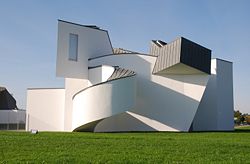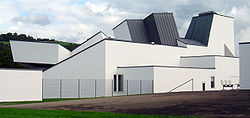
Vitra Design Museum
Encyclopedia

Design
Design as a noun informally refers to a plan or convention for the construction of an object or a system while “to design” refers to making this plan...
in Weil am Rhein
Weil am Rhein
Weil am Rhein is a German town and commune which is a suburb of the city of Basel in Switzerland. It is situated on the east bank of the River Rhine, and close to the point at which the Swiss, French and German borders meet. It is the most southwesterly town in Germany.-Geography:Weil am Rhein is...
, Germany
Germany
Germany , officially the Federal Republic of Germany , is a federal parliamentary republic in Europe. The country consists of 16 states while the capital and largest city is Berlin. Germany covers an area of 357,021 km2 and has a largely temperate seasonal climate...
.
Vitra
Vitra (furniture)
Vitra is a Swiss manufacturer of designer furniture. Vitra is the European manufacturer and retailer of the works of many internationally renowned furniture designers...
CEO Rolf Fehlbaum founded the museum in 1989 as an independent private foundation
Foundation (charity)
A foundation is a legal categorization of nonprofit organizations that will typically either donate funds and support to other organizations, or provide the source of funding for its own charitable purposes....
. The Vitra corporation provides it with a financial subsidy, the use of Vitra architecture, and organisational cooperation.
Collection and activities


Furniture
Furniture is the mass noun for the movable objects intended to support various human activities such as seating and sleeping in beds, to hold objects at a convenient height for work using horizontal surfaces above the ground, or to store things...
and interior design
Interior design
Interior design describes a group of various yet related projects that involve turning an interior space into an effective setting for the range of human activities are to take place there. An interior designer is someone who conducts such projects...
, is centered around the bequest
Bequest
A bequest is the act of giving property by will. Strictly, "bequest" is used of personal property, and "devise" of real property. In legal terminology, "bequeath" is a verb form meaning "to make a bequest."...
of U.S. designers Charles and Ray Eames, as well as numerous works of designers such as George Nelson
George Nelson (designer)
George Nelson was a noted American industrial designer, and one of the founders of American Modernism. While Director of Design for the Herman Miller furniture company both Nelson, and his design studio, George Nelson Associates, Inc., designed much of the 20th century's most iconic modernist...
, Alvar Aalto
Alvar Aalto
Hugo Alvar Henrik Aalto was a Finnish architect and designer. His work includes architecture, furniture, textiles and glassware...
, Verner Panton
Verner Panton
Verner Panton is considered one of Denmark's most influential 20th-century furniture and interior designers. During his career, he created innovative and futuristic designs in a variety of materials, especially plastics, and in vibrant and exotic colors...
, Dieter Rams
Dieter Rams
Dieter Rams is a German industrial designer closely associated with the consumer products company Braun and the Functionalist school of industrial design.- Life and career :...
, Jean Prouvé
Jean Prouvé
-Images:**- External links :***...
, Richard Hutten
Richard Hutten
Richard G. J. Hutten is a Dutch designer. Hutten started his own design studio in 1991 in Rotterdam after graduating from the Design Academy Eindhoven....
and Michael Thonet
Michael Thonet
Michael Thonet was a German-Austrian cabinet maker.Thonet was the son of master tanner Franz Anton Thonet of Boppard. Following a carpenter's apprenticeship, Thonet set himself up as an independent cabinetmaker in 1819. A year later, he married Anna Grahs, with whom he had seven sons and six...
. It is one of the world's largest collections of modern furniture design, including pieces representative of all major periods and styles from the beginning of the nineteenth century onwards.
These works, originally the private collection of Rolf Fehlbaum, are now not permanently on display, with the exception of a representative selection of designer chairs that can be seen in Zaha Hadid
Zaha Hadid
Zaha Hadid, CBE is an Iraqi-British architect.-Life and career:Hadid was born in 1950 in Baghdad, Iraq. She received a degree in mathematics from the American University of Beirut before moving to study at the Architectural Association School of Architecture in London.After graduating she worked...
's fire station on the Vitra premises. Instead, the museum puts on temporary collections focused on one particular designer, often with loans from other collections. In turn, parts of the collection are lent to other institutions around the world.
In addition, the museum produces workshops, publications and museum products, as well as maintaining an archive, a restoration and conservation laboratory, and a research library. It also organises guided tours of the Vitra premises
Vitra (furniture)
Vitra is a Swiss manufacturer of designer furniture. Vitra is the European manufacturer and retailer of the works of many internationally renowned furniture designers...
, a major attraction to those interested in modern architecture
Architecture
Architecture is both the process and product of planning, designing and construction. Architectural works, in the material form of buildings, are often perceived as cultural and political symbols and as works of art...
.
Museum building



Lörrach
Lörrach is a city in southwest Germany, in the valley of the Wiese, close to the French and the Swiss border. It is the capital of the district of Lörrach in Baden-Württemberg. The biggest industry is the chocolate factory Milka...
architect Günter Pfeifer. Together with the museum, which was originally just designed to house Rolf Fehlbaum's private collection, Gehry also built a more functional-looking production hall and a gatehouse for the close-by Vitra factory.
Although Gehry used his trademark sculptural deconstructivist
Deconstructivism
Deconstructivism is a development of postmodern architecture that began in the late 1980s. It is characterized by ideas of fragmentation, an interest in manipulating ideas of a structure's surface or skin, non-rectilinear shapes which serve to distort and dislocate some of the elements of...
style for the museum building, he did not opt for his usual mix of materials, but limited himself to white plaster and a titanium
Titanium
Titanium is a chemical element with the symbol Ti and atomic number 22. It has a low density and is a strong, lustrous, corrosion-resistant transition metal with a silver color....
-zinc
Zinc
Zinc , or spelter , is a metallic chemical element; it has the symbol Zn and atomic number 30. It is the first element in group 12 of the periodic table. Zinc is, in some respects, chemically similar to magnesium, because its ion is of similar size and its only common oxidation state is +2...
alloy. For the first time, he allowed curved forms to break up his more usual angular shapes. The sloping white forms appear to echo the Notre Dame du Haut
Notre Dame du Haut
Informally known as "Ronchamp", the chapel of Notre Dame du Haut in Ronchamp , completed in 1954, is one of the finest examples of the architecture of Franco-Swiss architect Le Corbusier and one of the most important examples of twentieth-century religious architecture.-History:Notre Dame du Haut...
chapel by Le Corbusier
Le Corbusier
Charles-Édouard Jeanneret, better known as Le Corbusier , was a Swiss-born French architect, designer, urbanist, writer and painter, famous for being one of the pioneers of what now is called modern architecture. He was born in Switzerland and became a French citizen in 1930...
in Ronchamp
Ronchamp
Ronchamp is a commune in the Haute-Saône department in the region of Franche-Comté in eastern France.It is located between the Vosges and the Jura mountains.-Notre Dame du Haut:...
, France
France
The French Republic , The French Republic , The French Republic , (commonly known as France , is a unitary semi-presidential republic in Western Europe with several overseas territories and islands located on other continents and in the Indian, Pacific, and Atlantic oceans. Metropolitan France...
, not far from Weil.
Architecture critic Paul Heyer described the general impression on the visitor as
The building backs the factory fence and is embedded in a meadow adorned with cherry tree
Cherry Tree
Cherry Tree may refer to:* A tree that produces cherries* An ornamental cherry tree that produces cherry blossomsPlaces* Cherry Tree, Pennsylvania, a borough in Indiana County, Pennsylvania, United States* Cherry Tree, Oklahoma...
s. Claes Oldenburg
Claes Oldenburg
Claes Oldenburg is a Swedish sculptor, best known for his public art installations typically featuring very large replicas of everyday objects...
's prominent sculpture Balancing Tools provides a colourful contrast, while Tadao Ando
Tadao Ando
is a Japanese architect whose approach to architecture was once categorized by Francesco Dal Co as critical regionalism. Ando has led a storied life, working as a truck driver and boxer prior to settling on the profession of architecture, despite never having taken formal training in the field...
's nearby conference pavilion gives a more muted one.
External links
- Homepage of the Vitra Design Museum
- Vitra Design Museum on greatbuildings.com
- Vitra Design Museum on the Guggenheim FoundationSolomon R. Guggenheim FoundationThe Solomon R. Guggenheim Foundation is a nonprofit corporation founded in 1937 by philanthropist Solomon R. Guggenheim and artist Hilla von Rebay. The first museum established by the foundation was the "Museum of Non-Objective Art", which was housed in rented space on Park Avenue in New York....
website

